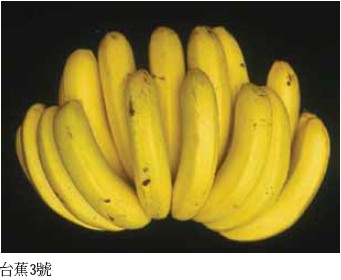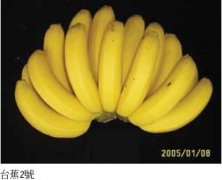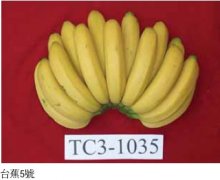The advantages and disadvantages of the new banana variety Taisao No. 3 and the key points of cultivation and management of Taisao No. 3
"Taisao No. 3" was discovered in 1980 by Mr. Chen Jinshou, a banana farmer in Dashu Township, Kaohsiung County, from a banana garden established by his "Taishu No. 1" tissue culture plantlet. After seven years of experimental study by the Taiwan Banana Research Institute, it has been proved that the wood species have the characteristics of both medium and short and resistant to yellow leaf disease, so it saves work and is resistant to wind, has excellent fruit shape and flavor, and has the characteristics of traditional bananas. It was examined and approved on September 14, 89, and was registered and named "Taisao No. 3", which was officially included in the promotion.
Characteristics of "Taisao No. 3"
◎ belongs to medium dwarf type with closely spaced petioles.
The leaves of ◎ are short and wide, and the tip of new leaves at heading stage is twisted and divided, which is its characteristic.
The birth cycle of ◎ is about 12-13 months, which is a little longer than that of "Beijiao".
◎ has the characteristics of resistance to yellow leaf disease, which is similar to "Taijiao No.1" and belongs to moderate disease resistance.
◎ plants are short and have strong wind tolerance, which can reduce the loss of wind damage under strong wind. The number of hands per cluster of ◎ is more, up to 811, but the last handle is small. ◎ fruit refers to the shape of Taiwan banana characteristics, moderate size, suitable for domestic and export standards. After ripening with ◎, the color was changed evenly, the pericarp was golden yellow, and the pulp flavor was good. The fruit hand of "Taisao No. 3" changed color evenly, showing a golden color, and the incidence of yellow leaf disease in Taisao No. 3 and the control varieties over the years.
Advantages and disadvantages of "Taisao No. 3"
Advantages
◎ has the characteristic of disease tolerance and the yield is stable when planted in the disease area.
◎ has the advantages of dwarfism, labor saving, wind resistance and saving support equipment, and can improve the efficiency of banana garden management.
The incidence of two-stage coloring in ◎ fruit chamber is low, and the fruit handle is moderate in size with traditional banana flavor, so it is suitable for domestic and foreign markets.
Shortcoming
◎ is vulnerable to thrips, causing rust spots on the pericarp and affecting commodity value.
◎ winter banana produced by this species and planted in barren areas, the fruit is smaller and the yield is low.
◎ the fruit handle of this species is numerous, but the end handle is too small to be up to standard and should be removed.
Key points of cultivation and Management of "Taisao No. 3"
The adaptability of this species to soil and climate is not as wide as that of "Beijiao". Therefore, the planting of this product must pay attention to its characteristics in order to achieve the desired results.
◎ banana plantation selection: this species is resistant to yellow leaf disease and is suitable for planting in the southern mild to moderate epidemic areas, but it will still occur in seriously diseased areas or poorly drained disease gardens, so it is not suitable for planting. Therefore, it is appropriate to choose banana orchards with deep soil layer, good drainage and soil rich in organic matter. Because of the different climate patterns, the eastern and central banana plantations are not suitable to plant strains.
◎ planting period and planting density: the growth cycle of this species is about 12-13 months. If it is in soil and well-drained banana plantation, it can be planted between March and April. If the soil condition is poor, it can be planted 2 to 3 months in advance. The planting density can be 7 X 7 feet, and 2000 plants can be planted per hectare.
Early cultivation and management of ◎: because of its dwarfism, the plant height increases slowly in the early stage, so there is no need for excessive fertilizer, but attention should be paid to weed control. Prevent spraying to the plant when using herbicide to avoid damage. For planting in February and March, it is necessary to strengthen aphid control and reduce the spread of mosaic disease. Covered with silver reflective plastic cloth can control weeds and prevent aphids.
◎ fertilizer application: the same as "Taijiao No. 1", No. 4 Futai fertilizer can be applied, the amount of fertilizer per plant is about 1.5kg, with a small amount of more fertilizer, the fertilizer effect is better.
◎ wind damage prevention: although this species is more wind-resistant, it still needs to be inserted into the wind-proof pillar to prevent wind damage. However, the pillar can be about one meter shorter than the traditional pillar.
◎ leaf protection: same as general banana (refer to plant protection manual).
◎ water rust control: same as "Taisao No.1". The following methods can be used for prevention and control: when the bud is about to be extracted, the plants heading in October and November are sprayed with 5% poisonous silk or 10% trimethoprim granules on the leaf sheath at the top of the stem, with a dosage of 15 grams per plant, or during heading, 3000 times of dimethamine (Daxi) solution is sprayed every 10 days.
◎ de-sprouting and remaining sprouting: the number of absorbing buds of this species is obviously less than that of ordinary bananas, and its growth is slower, which can reduce the times of degermination. If you want to leave buds for planting, you should start to grow buds earlier than "Bei Jiao".
◎ whole handle and fruit thinning: large banana should be used for proper fruit thinning to reduce the influence of triple fingers on fruit type. At last, the banana is too small and should be removed. It is suggested that winter bananas and Hualong bananas should be reserved for 6 and 7, and spring bananas for 7 and 8.
◎ bagging: blue PE or brown paper set can be used. If PE bagging is used, newspapers should be padded inside to prevent sunburn. At low temperature, pay attention to field irrigation and early bagging to reduce the degree of cold injury of fruit cart.
◎ harvest maturity control: the fullness rate of this kind of fruit room is slower, and the harvest time is about 2 to 3 weeks later than that of "Beijiao".

- Prev

Introduction of Taiwan banana variety Taisao 2, banana growth habits and resistance to yellow leaf disease
The existing banana varieties in the province are mainly Cavendish and Xianren bananas, which are of medium-high type and are not easy to be managed and harvested. At the same time, it is often damaged by the wind. The dwarf banana plant of Babedo is short and strong, which can reduce the loss of wind damage, reduce labor and improve the banana garden.
- Next

The difference between banana variety Taijiao 5 and Beijiao, which has better disease resistance between Taijiao 5 and Beijiao?
"Taisao No. 5", commonly known as "Yushan", is from the same family as "Bei Jiao". It is a descendant of the great-grandson of "Bei Jiao". It is selected from the third generation of "Bei Jiao". In appearance, the parents and grandchildren are very similar. The height of the new plant is about 250 cm 280 cm, and the circumference of the pseudo stem is 69 cm 72 cm, depending on the season.
Related
- A course of planting techniques and methods on how to grow carrots
- How to plant the latest tulips?
- Is it better to pick tea in the morning or in the afternoon? When is the best time for tea to be picked? what is the third or fifth tea?
- Launch Yuanxiao Happy combination Haocha + Tea Yuan healthy Taste
- Penghu Tourism "Fireworks 20 Parade with You"
- 2022 West Lake Happiness holds "Digital Revitalization Voucher" and draws iphone13 and laptop.
- Banqiao Fuzhou social houses are designed to change start-up combined with police elimination to create a safe and livable environment
- The convenient measure of "mechanical weeding" in Xinbei has been abused and the Agriculture Bureau has imposed heavy penalties on the illegal land consolidation.
- Changgeng University Joins Hands with Four Memory Factories to Rescue Memory Talent Shortage
- The list of Taiwan's top 100 MVP managers is listed by the Director-General of the Farmers' Association of Sanxia District.

